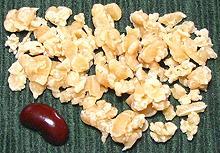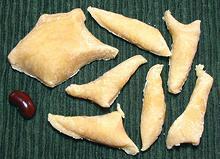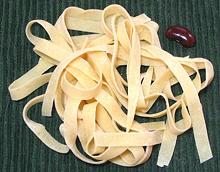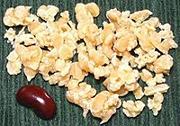
(click to enlarge)
Tarhonya
- [Egg Barley, Rivilchas]Tarhonya is a typical Hungarian pasta you can easily make fresh - or you can make a lot of it and dry it. Hungarian families once made tarhonya by the sack full in August when it would sun dry well, then used it over the winter. Tarhonya is often fried in butter or bacon fat until golden before adding to soup.
- Grate dough balls on the coarse side of a grater. Don't let them pile up or they may stick together - spread on a baking sheet.
- Let dry on a towel for 1/2 hour before using, shuffling occasionally for even drying.
- Cook in plenty of salted water and give them about 7 minutes after the water comes back to a boil to become tender all the way through. Strain them out and tumble with a few drops of butter or olive oil to keep them from sticking together.
- DRIED: spread out on cloth and sun dry or spread on baking sheets and dry in a barely warm oven. Shuffle occasionally for even drying.

(click to enlarge)
Csipetke
Csipetke is a fresh pasta often used in stews. Some recipes call for rolling the dough thin before pinching off, but I much prefer the Magyar campfire texture you get from pinching off the ball.
- Take a dough ball and pinch off pieces smaller than a dime and pinched quite thin.
- Let dry on a towel for 1/2 hour before using, shuffling occasionally for even drying.
- Cook in plenty of salted water and give them about 10 to 15 minutes after the water comes back to a boil to become tender all the way through and float up to the surface. Strain them out and tumble with a few drops of olive oil to keep them from sticking together.

(click to enlarge)
Galuska
- [Soft Dumplings]An essential dumpling for many Hungarian dishes. It is said that if you can't make galuska you can't cook Hungarian - but I can't see how anyone would be unable to make these.
- Roll dough balls out to between 1/4 and 1/2 inch thick and then cut with the edge of a spoon or some such device to make irregular pieces about 1 x 3/8 x 3/8 inch or as you like.
- Spread out on a towel and let dry for about 1/2 hour, shuffling occasionally for even drying.
- Bring plenty of salted water to a boil. Dump in a galuska, bring back to a boil and keep at a fast simmer until they are done. This can be anywhere from 30 minutes to over 1 hour depending on shape and thickness. Strain them out and tumble in a bowl with a little melted butter or a few drops of oil so they don't stick together.

(click to enlarge)
Tészta
Noodles are now used in a great many Hungarian dishes, cut into many sizes.
- Roll dough balls out as thin as you can on a floured board and let dry for a little while. Slice to the desired width, which may be wide or may be as narrow as you can cut it, or may be small squares.
- Spread out on a towel or hang over a pin or wire (depending on shape) and let dry for about 1/2 hour, shuffling occasionally for even drying if on a towel sheet.
